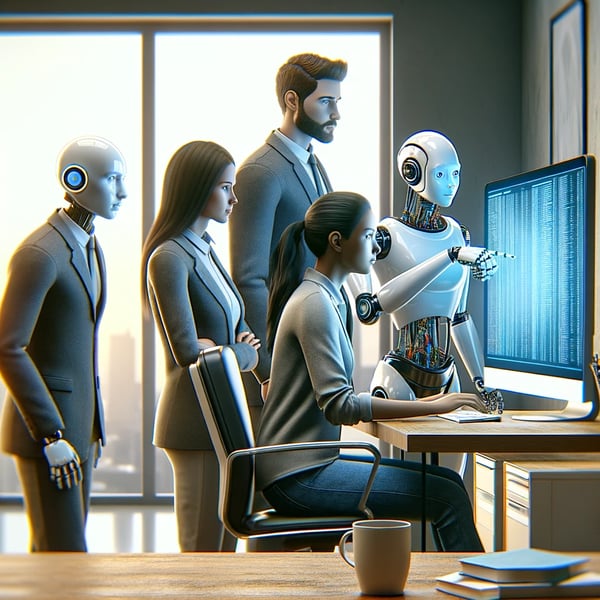In an era dominated by technological advancements, the integration of artificial intelligence into various facets of business operations has become increasingly prevalent. From automating routine tasks to enhancing decision making processes, AI holds the promise of streamlining workflows and improving efficiency.
One area where AI is making significant inroads is workplace communications. The use of AI generated content in employee messages is gaining traction, offering both benefits and challenges for organizations.
AI is progressing rapidly to help workplace communications in various ways.

- Natural Language Processing (NLP). AI powered NLP algorithms can analyze and understand human language, enabling chatbots and virtual assistants to communicate with employees, answer queries and provide assistance.
- Automation. AI automates routine communication tasks, such as email responses, scheduling meetings, and managing calendars. This improves efficiency and frees up time for employees to focus on more strategic initiatives.
- Voice Recognition. Voice recognition technology enables employees to interact with communication tools using voice commands. This facilitates hands free communication and improves accessibility.
- Translation Services. AI powered translation services can translate communication materials, such as emails and documents, into multiple languages. This helps with global communication and collaboration among diverse teams.
- Predictive Analytics. AI uses predictive analytics to anticipate employee communication needs and preferences, enabling organizations to proactively deliver relevant information and improve communication effectiveness.
Benefits of AI Generated Employee Messages

Artificial intelligence, when used correctly, can supercharge your internal communications.
Time Efficiency
One of the primary advantages of using AI generated content in workplace communications is the significant time savings it offers. It can quickly draft messages, announcements, and responses, freeing up valuable time for employees to focus on higher value tasks.
Consistency
AI ensures consistency in messaging across various communication channels. It adheres to predefined guidelines and tone, reducing the risk of inconsistencies or errors that may arise from human intervention.
Scalability
With AI, organizations can scale their communication efforts effortlessly. Whether it's sending personalized messages to individual employees or disseminating information to a large workforce, these tools can handle the task efficiently regardless of scale.
Personalization
Algorithms can analyze vast amounts of data to personalize messages based on individual preferences, roles and past interactions. This level of personalization enhances employee engagement and fosters a sense of connection with the organization.
Challenges of AI Generated Employee Messages

While the benefits of using artificial intelligence for your company's internal messaging are vast, there are key considerations to be mindful of.
Lack of Emotional Intelligence
One of the significant challenges of using AI in workplace communications is its inability to comprehend and convey emotions effectively. Such messages may come across as impersonal or devoid of empathy, particularly in sensitive situations.
Risk of Misinterpretation
AI may misinterpret nuances in language or context, leading to inaccuracies or misunderstandings in communication. This can be especially problematic in complex scenarios requiring nuance.
Overreliance on Technology
Overreliance on AI for communication may undermine human to human interactions and diminish the interpersonal connections essential for a thriving workplace culture.
Data Privacy Concerns
AI relies on vast amounts of data to generate content, raising concerns about data privacy and security. Organizations must ensure compliance with data protection regulations and safeguard sensitive employee information.
Adaptability and Flexibility
AI may struggle to adapt to rapidly changing situations or unexpected events, limiting its effectiveness in dynamically evolving communication scenarios.
How to Use AI in Workplace Communications
![]()
When using this new tool, be mindful of the following considerations.
Supplement, Not Replace Human Interaction
Use AI as a supplement to human communication rather than a replacement. Reserve it for routine tasks and standard messages, while keeping more complex or sensitive communications for human intervention.
Training and Oversight
Provide adequate training to employees responsible for overseeing internal content. Monitor and review these messages to ensure accuracy, relevance and adherence to organizational standards.
Balance Personalization and Privacy
Strike a balance between personalization and privacy when leveraging AI for employee messages. Respect employee privacy rights and ensure transparent communication about data usage and privacy policies.
Continuous Improvement
Regularly evaluate the effectiveness of AI generated content and solicit feedback from employees. Use insights gained to refine their algorithms and improve the quality of communication over time.
Embrace a Human Centric Approach
Maintain a human centric approach to workplace communications, emphasizing empathy, authenticity and human connection. Combine the efficiency of AI with the emotional intelligence of human interaction to create a balanced communication strategy.
Examples of Effective Use of AI in Workplace Communications

While AI is still a fledgling technology, there are a lot of practical uses you can utilize right now.
Automated Email Responses
AI powered email response systems can generate personalized responses to common inquiries, such as meeting scheduling, without human intervention. For example, Gmail's Smart Reply feature suggests quick responses based on the content of incoming emails, saving time for employees.
Chatbots for Employee Support
Chatbots integrated into internal messaging platforms can provide instant support to employees regarding HR policies, IT issues or general inquiries. For instance, Slack's Slackbot can answer FAQs, provide onboarding information or assist with scheduling tasks, enhancing employee productivity.
Virtual Assistants for Meeting Management
Virtual assistants can help employees manage their schedules, set reminders and join virtual meetings seamlessly. You can use Microsoft’s assistant to send meeting reminders, suggest available meeting times and even transcribe meeting notes, simplifying the meeting coordination process.
Personalized Newsletters and Updates
AI algorithms can analyze employee preferences and behaviors to curate personalized newsletters or updates. For instance, platforms like Smarp can deliver tailored news articles, industry updates and company announcements to employees based on their interests and roles, fostering engagement and knowledge sharing.
Automated Survey Analysis
AI powered survey analysis tools can process employee feedback quickly and provide actionable insights for organizational improvement. For example, platforms like Qualtrics analyze survey responses, identify trends and generate visual reports, enabling HR teams to make data driven decisions that enhance employee satisfaction and engagement.
By leveraging AI in these areas, organizations can improve efficiency, enhance employee experience, and foster a culture of continuous communication and engagement.
Adopting a strategic approach that balances the advantages of AI with human centric communication principles, organizations can harness the full potential of artificial intelligence in enhancing workplace communications while mitigating associated risks.
